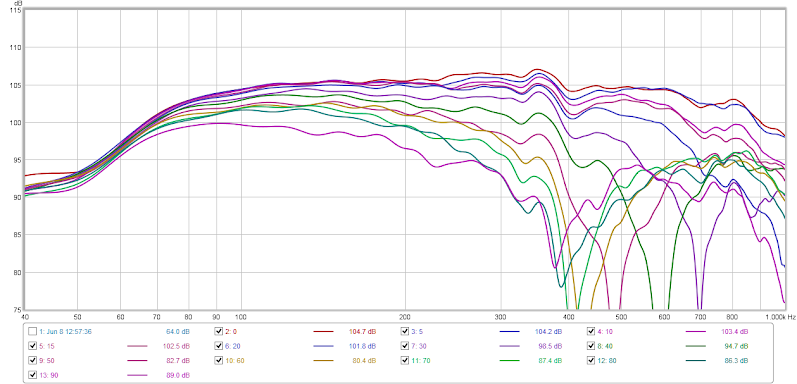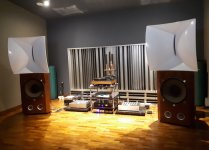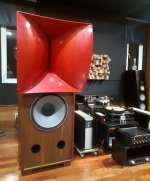Found this reprint of an old interview with George Augspurger on Control Room Acoustics and Studio Monitor design (Recording Engineer/Producer (RE/P) Magazine, March / April 1974 issue).
What say you?
Sure! Changing times......... the pioneers began with just 8 W IIRC, so systems had to be max efficient and accept its size, etc., shortcomings. Neither did they initially concern themselves too much with a BW wider than the analog telephone's 250-2500 Hz decade.
GM
I think the main factor in listening distance is the number of drivers and directivity
There are so many factors involved with a loudspeaker in an arbitrary room, that it's very hard to be conclusive in this respect.
Ideally, you want a loudspeaker system that more or less 'gets the room out of the way'. A Synergy or MEH comes to mind.
camplo, I came across a post by natehansen66, he's also a member of this forum.
These are directivity plots of his dual AE TD15M in 3 cu ft sealed cabs, angled in to create about a 120° angle between the baffles. Ground plane measurement at about 12' (I believe this was done in order to mimic Augspurger monitors):

This is his thread on his DIY fiberglass 18" EOS waveguides.
These are directivity plots of his dual AE TD15M in 3 cu ft sealed cabs, angled in to create about a 120° angle between the baffles. Ground plane measurement at about 12' (I believe this was done in order to mimic Augspurger monitors):

This is his thread on his DIY fiberglass 18" EOS waveguides.
Last edited:
It's rubbish.OK heres another argument I got myself into, I didn't necessarily support the idea of a driver being "too big" for a given room size.
...
What do you guys think.
In the Augsperger interview the JBL 2220 is referred to.
IMHO & FWIW, the "B" series is one of the best looking 15s ever.
IMHO & FWIW, the "B" series is one of the best looking 15s ever.
An externally hosted image should be here but it was not working when we last tested it.
An externally hosted image should be here but it was not working when we last tested it.
An externally hosted image should be here but it was not working when we last tested it.
Last edited:
Seating is approximately ~ 18 feet to the front wall, so roughly ~16 feet to the speakers, almost 5 meters. To produce 105 dB at the seating from each channel takes a decent amount of power.
OK, but why does this decide parallel Vs series wired? I mean in parallel you're using way more current, which heats up the VCs quicker, holds it longer = higher average and peak temps = higher effective Qts with the potential upside of lower inductance [Le] whereas the increased [Le] in series can be either a bonus or not depending on how much it has and the intended app.
Anyway, I'm old school, so my query was a many decades old rote response without remembering that 16 ohm rated amps are MIA in mainstream audio, so never mind.
GM
An externally hosted image should be here but it was not working when we last tested it.
What we got going on here 🤔🤔🤔
Ask the builder ! He is also a member of this forum !!! Have you seen the end-product as well ? There is felt over the slots in order to get resistive loading.
Regarding speakers too large fo a certainn room: There is some truth to it because you will need to sit farther away when using lots of large drivers because of better driver integration. Thats where the need for larger room dimensions come from. Driver integration wouldn't work well in the nearfield with a large four-way speaker for instance. There is of course a chance to get it right with setting the correct delays and driver corrections on a DSP. But that large four-way that has been tuned to be listened to in one exact nearfield spot wouldn't work that well anymore at a larger distance in turn.
If a Speaker is optimised for a larger listening distance then there is a greater range of listening distances where it works fine.
Regards
Charles
Regarding speakers too large fo a certainn room: There is some truth to it because you will need to sit farther away when using lots of large drivers because of better driver integration. Thats where the need for larger room dimensions come from. Driver integration wouldn't work well in the nearfield with a large four-way speaker for instance. There is of course a chance to get it right with setting the correct delays and driver corrections on a DSP. But that large four-way that has been tuned to be listened to in one exact nearfield spot wouldn't work that well anymore at a larger distance in turn.
If a Speaker is optimised for a larger listening distance then there is a greater range of listening distances where it works fine.
Regards
Charles
OK, but why does this decide parallel Vs series wired? I mean in parallel you're using way more current, which heats up the VCs quicker, holds it longer = higher average and peak temps = higher effective Qts with the potential upside of lower inductance [Le] whereas the increased [Le] in series can be either a bonus or not depending on how much it has and the intended app.
Anyway, I'm old school, so my query was a many decades old rote response without remembering that 16 ohm rated amps are MIA in mainstream audio, so never mind.
GM
Hi GM, I still get that voice coil heating is the same either in series or parallel.
Take 800W applied to 2 ohms parallel. P=I^2*R 800W=20A^2*2R. V=40
Each driver sees 40V, and 1/2 the total current or 10A
Take 800W applied to 8 ohms in series. P=V^2/R 800W=80V^2/8R A= 10
Each driver sees 1/2 the total voltage or 40V, and 10A
So, if math is correct ?, there is the same voltage and current to each individual driver either way.
Only difference is demands on amp...current vs voltage.
I strongly suspect the wiring choice is primarily being made based on amp wattage output specs.
The amp being used is stronger current wise, than voltage wise.
An externally hosted image should be here but it was not working when we last tested it.
What we got going on here ������
It's a (variable) resistance enclosure.
More info here.
Last edited:
Only difference is demands on amp...current vs voltage.
I strongly suspect the wiring choice is primarily being made based on amp wattage output specs.
The amp being used is stronger current wise, than voltage wise.
Yes, but once you drop to a constant 2 Ohm load....
For PA or HT it's another story (if the number of available amps is limited), but the (professional) amp designers I know, as well as loudspeaker builders all prefer a minimum load of 4 Ohms, or (better): 8 Ohms or higher (for tubes).
It may come across as 'audiophool rubbish' to some, but from my experience low power amps tend to sound better.
That's my conclusion after comparing several high end pro amps (MC2 and the like) to mid and higher end consumer amps (tubes, class A, A/B, D etc.).
Why not make optimal use of the higher efficiency that larger drivers entail?
Last edited:
Yes, but once you drop to a constant 2 Ohm load....
For PA or HT it's another story (if the number of available amps is limited), but the (professional) amp designers I know, as well as loudspeaker builders all prefer a minimum load of 4 Ohms or better: 8 Ohms or higher (for tubes).
Yeah, I'm not a fan of 2 Ohm loads either, even for PA use. There are a few prosound amps such as Linea Research and Powersoft that I'd be happy running at 2R.
The QSC PLX's don't fall in that category. IME, they need a real stiff line supply to keep from dropping out at 2R.
QSC's PL3's and PLD's are OK, but PA inevitably uses longer speaker wires, and damping factor realistically becomes an issue.
The last nail in the coffin for 2R imo, is it is usually used for gaining wattage.
But like diyuser2010 pointed out, thermal compression kicks in waay earlier than most folks realize, so what's the point?
I've heard folks say the point is for headroom.....but headroom comes from maintaining necessary rail voltage, and as per earlier thread, voltage and current to individual drivers remains the same...
Wattage is really a confusing, muddy spec, ....
Yeah, I'm not a fan of 2 Ohm loads either, even for PA use. There are a few prosound amps such as Linea Research and Powersoft that I'd be happy running at 2R.
The QSC PLX's don't fall in that category. IME, they need a real stiff line supply to keep from dropping out at 2R.
QSC's PL3's and PLD's are OK, but PA inevitably uses longer speaker wires, and damping factor realistically becomes an issue.(
Agreed, that's why I stated: "those amps tend to be quite expensive".
You could build a high quality large format 2 way stereo loudspeaker system and have enough money left to buy amps, dsp and a nice (used) workstation for the price of one Linea Research amp.
Last edited:
Regarding speakers too large fo a certain room: There is some truth to it because you will need to sit farther away when using lots of large drivers because of better driver integration. Thats where the need for larger room dimensions come from. Driver integration wouldn't work well in the nearfield with a large four-way speaker for instance. There is of course a chance to get it right with setting the correct delays and driver corrections on a DSP. But that large four-way that has been tuned to be listened to in one exact nearfield spot wouldn't work that well anymore at a larger distance in turn.
If a Speaker is optimised for a larger listening distance then there is a greater range of listening distances where it works fine.
Regards
Charles
This is true. I've found 2-ways are the easiest to work with, in a large variety of rooms. This applies to both small (BBC type) monitors and larger cabs + horn / wg.
Again, a Synergy / MEH would be better still.
Last edited:
I am sure even these could work wonderfully. Yes, those are 2241H 18s (thanks to GM for the reference to the FB page, earlier).
Attachments
Last edited:
- Home
- Loudspeakers
- Multi-Way
- Is it possible to cover the whole spectrum, high SPL, low distortion with a 2-way?


